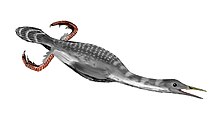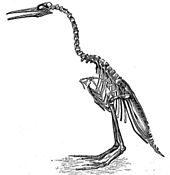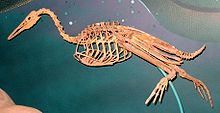「ヘスペロルニス」の版間の差分
編集の要約なし |
m 解消済み仮リンクParahesperornis alexiを内部リンクに置き換えます (今回のBot作業のうち54%が完了しました) |
||
| (9人の利用者による、間の18版が非表示) | |||
| 1行目: | 1行目: | ||
{{生物分類表 |
{{生物分類表 |
||
|名称=ヘスペロルニス |
|名称=ヘスペロルニス |
||
|画像=[[ |
|画像=[[File:Hesperornis regalis (1).jpg |250px]] |
||
|画像キャプション= |
|画像キャプション= ''H. regalis'' の復元骨格 |
||
|省略=鳥綱 |
|省略=鳥綱 |
||
|亜綱=真鳥亜綱 [[:en:Ornithurae|Ornithurae]] |
|亜綱=真鳥亜綱 [[:en:Ornithurae|Ornithurae]] |
||
|目= ヘスペロルニス目<BR> [[:en:Hesperornithiformes|Hesperornithiformes]] |
|目= [[ヘスペロルニス目]]<BR> [[:en:Hesperornithiformes|Hesperornithiformes]] |
||
|科= ヘスペロルニス科<BR> Hesperornithidae |
|科= [[ヘスペロルニス科]]<BR> Hesperornithidae |
||
|属= '''ヘスペロルニス'''<BR> ''[[:en:Hesperornis|Hesperornis]]'' |
|属= '''ヘスペロルニス属'''<BR> ''[[:en:Hesperornis|Hesperornis]]'' |
||
|下位分類名=種 |
|下位分類名=種 |
||
|下位分類 = |
|下位分類 = |
||
* |
*'''''H. regalis''''' <small>Marsh, 1872</small> |
||
* |
*'''''H. crassipes''''' <small>(Marsh, 1876)</small> |
||
* |
*'''''H. gracilis''''' <small>Marsh, 1876</small> |
||
* |
*'''''H. altus''''' <small>(Marsh, 1893)</small> |
||
* |
*'''''H. montana''''' <small>Schufeldt, 1915</small> |
||
* |
*'''''H. rossicus''''' <small>Nesov & Yarkov, 1993</small> |
||
* |
*'''''H. bairdi''''' <small>Martin & Lim, 2002</small> |
||
* |
*'''''H. chowi''''' <small>Martin & Lim, 2002</small> |
||
* |
*'''''H. macdonaldi''''' <small>Martin & Lim, 2002</small> |
||
* |
*'''''H. mengeli''''' <small>Martin & Lim, 2002</small> |
||
*'''''H. lumgairi''''' <small>Aotsuka & Sato, 2016</small> |
|||
* ''H. lumgairi'' <small>Aotsuka & Sato, 2016 (in press)</small> <ref>{{Cite journal|author=Keiichi Aotsuka and Tamaki Sato |year=2016 |title=Hesperornithiformes (Aves: Ornithurae) from the Upper Cretaceous Pierre Shale, Southern Manitoba, Canada |journal=Cretaceous Research |volume=in press |issue= |pages= |doi=10.1016/j.cretres.2016.03.003 }}</ref> |
|||
|タイプ種 = ''Hesperornis regalis'' {{AUY|Marsh|1872}} |
|タイプ種 = ''Hesperornis regalis'' {{AUY|Marsh|1872}} |
||
| シノニム = |
| シノニム = |
||
| 26行目: | 26行目: | ||
* ''Coniornis'' {{AUY|Marsh|1893}} |
* ''Coniornis'' {{AUY|Marsh|1893}} |
||
* ''Hargeria'' {{AUY|Lucas|1903}} |
* ''Hargeria'' {{AUY|Lucas|1903}} |
||
}} |
|||
}} <!-- このテンプレートは、PJ:BIOでの議論に基づき、Bot(User:Point136)により移行されました。 --> |
|||
'''ヘスペロルニス'''([[学名]]:'''''Hesperornis''''')は、[[後期白亜紀]]の[[カンパニアン]]期の前半にかけて生息した、[[ウ科]]に類似した[[水鳥]]の[[属 (分類学)|属]]。翼は退化していて尾と共に推進方向の調整に用いられ、推進力は後肢で生み出されていたと考えられている。遊泳能力が高い一方で陸上での活動は不得意であったとも推測されている。 |
|||
'''ヘスペロルニス''' (学名:''Hesperornis'')は、[[絶滅]]した[[鳥類]]。 |
|||
発見は化石鳥類の中では早い部類であり、[[19世紀]]の[[化石戦争]]の間に[[オスニエル・チャールズ・マーシュ]]が発見した。[[化石]]は特に[[カナダ]]の海成[[頁岩]]や[[アメリカ合衆国]][[カンザス州]]の海成[[石灰岩]]層から産出している。9種が認められており、うち8種は[[北アメリカ大陸]]および[[ロシア]]から産出している。 |
|||
[[白亜紀]]後期に[[北アメリカ]]に生息していた[[海鳥]]類。アメリカの[[カンザス州]]で発見された。 |
|||
== 特徴 == |
|||
学名''Hesperornis''は、アメリカの[[古生物学|古生物学者]] [[オスニエル・チャールズ・マーシュ]]による命名(1872年)。「西の鳥」を意味する。 |
|||
[[Image:Hesperornis BW (white background).jpg|thumb|left|生体想像復元図]] |
|||
ヘスペロルニスは最大で全長1.8メートルに達する大型の鳥類であった<ref name = Perrins/>。翼は極めて小型で、後肢推進型であった。後肢の研究から、当初は[[アビ属]]などの[[水鳥]]に見られるような水かきのある足ではなく、現生の[[カイツブリ科]]に似て指の分かれた足を有していたと考えられていた<ref name="Stolpe1935">{{cite journal |last1=Stolpe |first1=M |title=Colymbus, Hesperornis, Podiceps: ein Vergleich ihrer hinteren extremitat |journal=Journal für Ornithologie |date=1935 |volume=83 |pages=115–128}}</ref>。ヘスペロルニス目と現生の海鳥の形態を観察した後続研究により、この解釈には疑問が投げかけられ、ヘスペロルニス目の足はどちらの形態もあり得るとされた<ref name="Bell2019">{{cite journal |last1=Bell |first1=Alyssa |last2=Wu |first2=Yun-Hsin |last3=Chiappe |first3=Luis |title=Morphometric comparison of the Hesperornithiformes and modern diving birds |journal=Palaeogeography, Palaeoclimatology, Palaeoecology |date=2019 |volume=513 |pages=196–207}}</ref>。 |
|||
小さな翼と平たい尾は推進力の源になっていたわけではないが、水中で推進方向を変更する際に[[舵]]としての役割を担ったと推測されている<ref name=ナショジオ>{{Cite web|和書|url=https://natgeo.nikkeibp.co.jp/nng/article/20141218/429129/ |title=ヘスペロルニス・レガリス |accessdate=2021-09-24 |date=2014-12-18 |publisher=[[ナショナルジオグラフィック協会]]}}</ref>。 |
|||
戦前には語源となった[[ヘスペリス]]の和訳から「黄昏鳥」の和名が付された<ref>石川成章『地球発達史』(大日本図書 1903)pp.176</ref>。 |
|||
[[イクチオルニス]]などの他の多くの[[中生代]]の鳥類と同様に、ヘスペロルニスには[[嘴]]と[[歯]]が共に存在した。ヘスペロルニス目の系統において、他の既知の鳥類(あるいは非鳥類型[[獣脚類]])と異なる様式で、歯はそれぞれの[[歯槽]]ではなく長軸方向の溝に収まっていた。これは[[モササウルス科]]と共通する<ref name=marsh1880/><ref name=Gregory/>。ヘスペロルニスの歯は[[歯骨]]と[[上顎骨]]のほぼ全体に亘って存在した。[[前上顎骨]]と[[前歯骨]]には歯が存在せず、おそらくは嘴に覆われていた。骨の表面の研究からは、少なくとも両顎の先端には現生鳥類に見られるものと同様の[[ケラチン]]質の硬い嘴が備わっていたことが示唆されている<ref name=heironymus2010/>。[[口蓋骨]]は顎を閉じた際に下顎の歯が収まることのできる小さな孔を有した<ref name=elzanowski1991/>。また、下顎の骨の間には恐竜型の関節が残っていた。このため彼らは下顎の前部と後部を独立に回転していた<ref name=Perrins/>。 |
|||
== 形態と生態 == |
|||
長い首・長いクチバシを持つその体型は現在の[[アビ]]類やウ類に似るが、体長は180cmとかなり大型である。翼は小さく痕跡程度に退化しており、現在の[[ペンギン]]類と同様に、飛ぶことはできない。 |
|||
しかし、ペンギンが翼が変化したフリッパーで海中を泳ぐのに対して、ヘスペロニスは水掻きを持つ後足で泳ぐ。そして現在の鳥類と決定的に異なる点は、[[クチバシ]]に歯を持つことである。このクチバシを使い、海中で[[魚類]]を捕食していたと推定される([[#外部リンク|外部リンク]]の生態想像図参照)。 |
|||
== 歴史 == |
|||
ヘスペロルニスは、白亜紀に登場した[[真鳥類]](Euornithes)のグループに含まれるが、白亜紀末期および[[K-Pg境界]]層を境に同じ年代・場所に生息した[[翼竜類]]や[[モササウルス類]]とほぼ同時に絶滅した。現存する鳥類にヘスペロルニス類の子孫はない。 |
|||
[[Image:Hesperornis Regalis - Project Gutenberg eText 16474.jpg|thumb|left|upright|マーシュによる ''H. regalis'' の1880年の復元図]] |
|||
ヘスペロルニスの最初の標本は1871年{{Refnest|group="注"|『よみがえる恐竜・古生物』によると1870年<ref name=よみがえる/>。}}に[[オスニエル・チャールズ・マーシュ]]により発見された。当時マーシュは10人の学生と共に二回目の合衆国西部での発掘調査を行っていた<ref>Thomson, 191.</ref>。マーシュが以前調査を行った[[カンザス州]]に一行が向かったところ、飛翔性の[[爬虫類]]である[[プテラノドン]]の化石が産出したのとは別に、彼は「最低でも高さ5フィートの大型化石鳥類」の骨格を発見した。頭部は存在しなかったものの、標本は大型で、翼がなく、脚が強靭であった。マーシュはこの標本が潜水性の種と考えた<ref>Thomson, 193.</ref>。マーシュはこの化石を ''Hesperornis regalis'' と命名した<ref name="Holtz2008">Holtz, Thomas R. Jr. (2011) ''Dinosaurs: The Most Complete, Up-to-Date Encyclopedia for Dinosaur Lovers of All Ages,'' [http://www.geol.umd.edu/~tholtz/dinoappendix/HoltzappendixWinter2010.pdf Winter 2010 Appendix.]</ref>。属名は[[日本語]]に訳すと「西の鳥」を意味する<ref name=よみがえる>{{Cite book|和書|page=135 |author1=ティム・ヘインズ|authorlink1=ティム・ヘインズ |author2=ポール・チェンバーズ |publisher=[[SBクリエイティブ]] |translator=椿正晴 |isbn=4-7973-3547-5 |date=2006-07-15 |title=よみがえる恐竜・古生物}}</ref>。 |
|||
翌年にマーシュはより少人数の発掘チームで西部に向かった。カンザス州西部にて、マーシュの4人の学生のうちの1人であったトーマス・H・ラッセルがヘスペロルニスの「ほぼ完全な骨格」を発見した<ref>Charles Schuchert and Clara Mae LeVene, ''O.C. Marsh: Pioneer in Paleontology'', p. 427. New York: Arno Press, 1978. Later, Russell assisted Marsh while attending medical school; he became a surgeon, professor of Clinical Surgery in the Yale School of Medicine, and Marsh's personal physician until Marsh's death in 1899. See ''Proceedings of the Connecticut State Medical Society'' (Google eBook) and ''Genealogical and Family History of the State of Connecticut: A Record of the Achievements of Her People in the Making of a Commonwealth and the Founding of a Nation.'' Editorial staff: William Richard Cutter, Edward Henry Clement, Samuel Hart, Mary Kingsbury Talcott, Frederick Bostwick, Ezra Scollay Stearns. Volume I (of 4). New York: Lewis Historical Publishing Company, 1911.</ref>。標本は十分な頭骨が保存されており、マーシュはその動物の顎に歯が並んでいることを確認できた<ref name="wallace-86">Wallace, 86.</ref>。彼は、ベンジャミン・マッジが発見した歯のある鳥[[イクチオルニス]]と共にこの発見が進化上重要な意味を持つと考え<ref>Thomson, 226.</ref>、1873年に論文を発表した<ref name="wallace-86"/>。なお、彼とライバル関係にあった[[エドワード・ドリンカー・コープ]]はマーシュに渡されるはずであったヘスペロルニスを含む化石の箱を偶然受け取ったことで関係がさらに悪化した。コープがヘスペロルニスについて「実に素晴らしい」とコメントした一方で、マーシュはコープが化石を窃盗したと非難の声を上げた<ref>Wallace, 87.</ref>。1873年までに彼らの友人関係は敵対関係へ変容し、[[化石戦争]]に拍車が掛かった。1873年以降マーシュは滅多にフィールドに姿を現わさなかったが、収集家が彼に化石を送り続けたため、最終的にヘスペロルニス50標本を受け取った。これにより、彼は以前よりも強く爬虫類と鳥類の間の進化を証明できるようになった<ref>Wallace, 132.</ref>。 |
|||
==分類体系== |
|||
*[[恐竜]] [[:en:dinosaur|dinosaur]] |
|||
*:[[竜盤類]] [[:en:Saurischia|Saurischia]] |
|||
*::[[獣脚類]] [[:en:Theropoda|Theropoda]] |
|||
*:::[[テタヌラ類]] [[:en:Tetanurae|Tetanurae]] |
|||
*::::[[コエルロサウルス類]] [[:en:Coelurosauria|Coelurosauria]] |
|||
*:::::[[マニラプトル形類]] Maniraptoriformes |
|||
*::::::[[マニラプトル類]] [[:en:Maniraptora|Maniraptora]] |
|||
*:::::::[[エウマニラプトル類]] Eumaniraptora |
|||
*::::::::[[鳥類]] [[:en:Aves|Aves]] |
|||
*:::::::::真鳥類 Ornithurae |
|||
== |
== 分類と種 == |
||
[[File:Hesperornis regalis fossil.jpg|thumb|upright|[[アメリカ自然史博物館]]の ''H. regalis'' 標本]] |
|||
{{古鳥類}} |
|||
ヘスペロルニス属には多くの種が記載されているが、いくつかの種は骨が非常に少なく、同様の大きさを持つ豊富(でかつ不完全)な分類群との正確な比較は不可能である。多くのケースでは、層序・産地・体サイズの相違によって種が区別されている。 |
|||
最初に記載された種は ''Hesperornis regalis'' であった。本種は最も知られている種でもあり、断片的なものからより完全な骨格まで多くの標本が発見されている。全ての標本は[[ニオブララ累層]]の[[スモーキー・ヒル・チョーク]]部層から産出している<ref name=carpenter2003/>。 |
|||
== 脚注 == |
|||
<references /> |
|||
本来は別属の ''Lestornis crassipes'' として命名する予定であったが、1876年にマーシュは新種 ''Hesperornis crassipes'' を命名した。本種は ''H. regalis'' よりも大型で、''H. regalis'' が4本の肋骨を持つのに対して5本の肋骨を有した。また、後肢と[[胸骨]]の装飾にも差異が見受けられた。''H. crassipes'' は ''H. regalis'' と同時に同じ場所から発見されており、不完全な一つの骨格が知られている。骨格には頭骨の一部や歯が含まれている<ref name=marsh1876/>。 |
|||
==外部リンク== |
|||
* [http://www.oceansofkansas.com/Hesperornis.html Hesperonis] (OCEANS OF KANSAS PALEONTOLOGY by Mike Everhart) |
|||
** [http://www.oceansofkansas.com/Hesperornis/kish-01.jpg 生態想像図(親と雛)] |
|||
** [http://www.oceansofkansas.com/Birds/BONNER-1.jpg 生態想像図(捕食1)] |
|||
** [http://www.oceansofkansas.com/Birds/sm-hesp1.jpg 生態想像図(捕食2)] |
|||
** [http://www.oceansofkansas.com/Hesperornis/hespercb.jpg 生態想像図(捕食3)] |
|||
** [http://www.oceansofkansas.com/Hesperornis/marhesp.jpg 骨格図] - Marsh(1872)による |
|||
** [http://www.oceansofkansas.com/Sternbrg/hesper4.jpg 骨格図(頭部詳細)] - クチバシの歯がよく分かる |
|||
[[File:Hesperornis gracilis.jpg|thumb|左|''H. gracilis'' の左脚]] |
|||
1876年にマーシュはニオブララ累層の ''H. regalis'' と同じ層準から発見された不完全な[[中足骨]]に ''H. gracilis'' と命名した。この標本は[[パラヘスペロルニス]]属の ''Parahesperornis alexi'' の分類の混乱に繋がった。''P. alexi'' のタイプ標本は長らく ''H. gracilis'' と同種のものと考えられていたが、Lucas (1903) により別属として扱われた際に、誤って ''Hargeria gracilis'' として記載されてしまった。このミスは後に修正され、''Hargeria'' はヘスペロルニスに戻り、そしてより特徴的な標本が[[パラヘスペロルニス]]に改名された<ref name=bellparahesp/><ref name=Mortimer/>。 |
|||
[[image:Coniornis.jpg|thumb|upright|''H. altus'' の右[[脛骨]](タイプ標本)]] |
|||
ニオブララ累層以外から報告された最初の種は、合衆国[[モンタナ州]]の[[ジュディスリバー累層]](あるいは{{仮リンク|シガレットシェール累層|en|Claggett Shale}})から部分的な後肢が知られている ''Hesperornis altus'' であった。マーシュはヘスペロルニスがカンザス州にしか生息しておらずモンタナ州のものは別属にすべきであると考えており、この標本は新属 ''Coniornis'' に位置付けられた。後の研究者の奥はこれに同意せず、本種をヘスペロルニス属に分類している<ref name=1915b/><ref name = martin1984/>。モンタナ州から報告された第二の種はシガレットシェール累層から記載された。単一の胴椎に基づいて1915年にShufeldtが ''H. montana''と命名した。''H. altus'' との形質の比較は不可能であるが、推定される体サイズは ''H. montana'' の方が小型であるため独立した属と解釈された <ref name=1915a/>。 |
|||
1993年、北アメリカ以外から初めてヘスペロルニス属の化石が新種として報告された。NessovとYarkovは[[ロシア]]の[[ヴォルゴグラード]]の付近に分布する下部カンパニアン階から産出した断片骨格に ''Hesperornis rossicus'' と命名し、同時代の堆積物に由来する他の複数の標本も本種に分類されている。全長は約1.4メートルで、[[カナダ]]の[[カナダガ]]よりも僅かに小さい程度であり、ヘスペロルニス属では最大の種である<ref name="Holtz2008"/>。大型の体サイズと地理的位置の相違点以外では、本種は平たい中足骨をはじめとする後肢や足の特徴で他の種と区別できる<ref name=ageofdinorussia>Kurochkin, (2000). "Mesozoic birds of Mongolia and the former USSR." Pp. 533–559 in Benton, Shishkin, Unwin and Kurochkin (eds.). ''The Age of Dinosaurs in Russia and Mongolia.''</ref>。 |
|||
2002年、これまでヘスペロルニス類と考えられていなかった化石について研究を行い、マーティンとリムが新種を発表した。命名された新種は非常に小型の''H. mengeli'' や ''H. macdonaldi''、僅かに大型の ''H. bairdi''、非常に大型の ''H. chowi'' であった。そのどれもが[[サウスダコタ州]]や[[アルバータ州]]に分布する{{仮リンク|ピエール頁岩累層|en|Pierre Shale}}のシャロンスプリングス部層から産出しており、年代は約8050万年前と見られている<ref name=martinlim2002/>。 |
|||
さらに、SGU 3442 Ve02 and [[ルンド大学|LO]] 9067t といった未分類の化石や、ロシアの[[ロストフ]]の未定種も存在する。前者の2つの標本はおそらく ''H. rossicus'' で、代わりに ''H. rossicus'' に属する標本のいくつかは後者の未同定の分類群に属すると見られている<ref name=ReesLindgren />。 |
|||
=== 系統関係 === |
|||
2015年に、ヘスペロルニス類の種レベルでの系統解析の結果が発表された<ref name=Bell2015>{{Cite journal | doi = 10.1080/14772019.2015.1036141| title = A species-level phylogeny of the Cretaceous Hesperornithiformes (Aves: Ornithuromorpha): Implications for body size evolution amongst the earliest diving birds| journal = Journal of Systematic Palaeontology| volume = 14| issue = 3| pages = 239–251| year = 2015| last1 = Bell | first1 = A. | last2 = Chiappe | first2 = L. M. }}</ref>。以下にその[[クラドグラム]]を示す。 |
|||
{{Clade |
|||
|label1=ヘスペロルニス類 |
|||
|1={{clade |
|||
|1=''[[パスキアオルニス|Pasquiaornis]]'' |
|||
|2={{clade |
|||
|1=''[[エナリオルニス|Enaliornis]]'' |
|||
|2={{clade |
|||
|label1=[[バプトルニス科]] |
|||
|1={{clade |
|||
|1=AMNH 5101 |
|||
|2=FMNH 395 |
|||
|3=''[[バプトルニス|Baptornis advenus]]'' }} |
|||
|2={{clade |
|||
|label1=[[ブロダヴィス科]] |
|||
|1={{clade |
|||
|1=''[[ブロダヴィス|Brodavis varneri]]'' |
|||
|2=''[[ブロダヴィス|Brodavis baileyi]]'' |
|||
}} |
|||
|2={{clade |
|||
|1=''[[フミコリス|Fumicollis hoffmani]]'' |
|||
|label2=[[ヘスペロルニス科]] |
|||
|2={{clade |
|||
|1=''[[パラヘスペロルニス|Parahesperornis alexi]]'' |
|||
|2='''''Hesperornis''''' |
|||
}} |
|||
}} |
|||
}} |
|||
}} |
|||
}} |
|||
}} |
|||
}} |
|||
== 古生物学 == |
|||
[[Image:Hesperornis regalis.jpg|thumb|遊泳姿勢の ''H. regalis'' 骨格]] |
|||
ヘスペロルニスは主に海棲で、[[西部内陸海路]]や[[ツルガイ海峡]]や[[北極海]]といった当時の[[大陸棚]]の広がる浅海域に生息していた<ref name=ReesLindgren/><ref name=Hills99 />。当時の環境は[[亜熱帯]]から[[熱帯]]の海水で、現在よりも温暖であった。しかし、既知の範囲内で最も新しいヘスペロルニスの標本は[[フォアモスト累層]]の内陸の淡水性堆積物中に発見されており、一時的にでも海から離れていた種がいたことが示唆されている。加えて、''H. altus'' の化石はジュディスリバー累層の基底に位置する淡水性堆積物に由来する<ref name=fox1974/>。 |
|||
四肢の長さや腰の骨の形状および[[寛骨臼]]の位置は現生の[[ハシグロアビ]]のものと特に類似しており、水中や陸上での移動様式も同様であったと推測されている。アビ属と同様に、ヘスペロルニスはおそらく優れた後肢推進型の潜水性鳥類であった一方、陸上の行動は不得手としていた<ref name=hesperornisdivingbirds />。また同様に脚は足首まで体の中に収納し、足は尾の近くで横に飛び出していたと推測される。そのため、脚を体の下にして立ったり、重心の下にして歩いたり、といった行動は不可能であったと見られている。代わりに、現在の[[アザラシ]]のように、腹部で体を押して陸上を移動していたと推測されている<ref name=Brodavis/>。しかし、ヘスペロルニス類の後肢に関するより新しい研究では、直立歩行する[[ウ科]]の後肢との機能的類似性が指摘されている<ref>{{Cite journal |doi = 10.1016/j.palaeo.2017.12.010|title = Morphometric comparison of the Hesperornithiformes and modern diving birds|journal = Palaeogeography, Palaeoclimatology, Palaeoecology|volume = 513|pages = 196–207|year = 2019|last1 = Bell|first1 = Alyssa|last2 = Wu|first2 = Yun-Hsin|last3 = Chiappe|first3 = Luis M.|bibcode = 2019PPP...513..196B}}</ref>。 |
|||
若いヘスペロルニスの個体は現生鳥類と同様に急速かつ継続的に成長して成鳥になったと推測されている。これは[[エナンティオルニス類]]とは異なる成長パターンである<ref name=Chinsamy98 />。 |
|||
=== 捕食者 === |
|||
デイヴィッド・バーンハムらが1960年代に行った研究により、ヘスペロルニスの後肢には[[ドリコリンコプス]]またはその近縁属と思われる若い{{仮リンク|ポリコティルス科|en|Polycotylidae}}の[[首長竜]]による噛み跡が発見されている。この標本の顆からは感染の兆候が見られており、当該個体が脚を噛まれた後に逃れて生き延びたことが示唆されている<ref name=BBC>{{Cite web|url=http://www.bbc.com/earth/story/20160311-how-a-bird-managed-to-escape-a-predatory-sea-monster |accessdate=2021-09-24 |archivedate=2016-05-20 |date=2016-05-12 |publisher=[[英国放送協会|BBC]] |archiveurl= https://web.archive.org/web/20160520051300/http://www.bbc.com/earth/story/20160311-how-a-bird-managed-to-escape-a-predatory-sea-monster |author=Robin Wylie |title=How a bird managed to escape a predatory sea monster}}</ref>。また、この他にも海中では[[ティロサウルス]]をはじめとする<ref name=ナショジオ/>[[モササウルス科]]や[[サメ]]<ref name=BBC/>、陸上では獣脚類の[[恐竜]]がヘスペロルニスを捕食していたと考えられている。巣は[[翼竜]]の被害に遭った可能性もある<ref name=よみがえる/>。 |
|||
== 脚注 == |
|||
{{commons|category:Hesperornis}} |
{{commons|category:Hesperornis}} |
||
{{脚注ヘルプ}} |
|||
=== 注釈 === |
|||
{{Reflist|group=注}} |
|||
=== 出典 === |
|||
{{Reflist|25em|refs=<ref name=1915a>{{cite journal|author=Shufeldt, R.W. |year=1915|title=The fossil remains of a species of ''Hesperornis'' found in Montana|journal=The Auk|volume=32|issue=3|pages= 290–294|url=http://sora.unm.edu/node/10358|doi=10.2307/4072679|jstor=4072679}}</ref><ref name=1915b>{{cite journal|author=Shufeldt, R.W. |year=1915|title=Fossil birds in the Marsh Collection of Yale University|journal=Transactions of the Connecticut Academy of Arts and Sciences|volume=19|pages= 1–110}}</ref><ref name=bellparahesp>{{cite journal|author1=Bell, A. |author2=Everhart, M.J. |year=2009|title=A new specimen of ''Parahesperornis'' (Aves: Hesperornithiformes) from the Smoky Hill Chalk (Early Campanian) of Western Kansas|journal=Transactions of the Kansas Academy of Science|volume=112|issue=1/2|pages= 7–14|doi=10.1660/062.112.0202}}</ref><ref name=Brodavis>{{cite journal |author1=Larry D. Martin |author2=Evgeny N. Kurochkin |author3=Tim T. Tokaryk |year=2012 |title=A new evolutionary lineage of diving birds from the Late Cretaceous of North America and Asia |journal=Palaeoworld |volume=21 |issue=1 |pages=59–63 |doi=10.1016/j.palwor.2012.02.005}}</ref><ref name=carpenter2003>{{cite journal|author=Carpenter, K. |year=2003|title=Vertebrate Biostratigraphy of the Smoky Hill Chalk (Niobrara Formation) and the Sharon Springs Member (Pierre Shale)|journal=High-Resolution Approaches in Stratigraphic Paleontology|volume=21|pages= 421–437|doi=10.1007/978-1-4020-9053-0|series=Topics in Geobiology|editor1-last=Harries|editor1-first=P. J|isbn=978-1-4020-1443-7}}</ref><ref name=Chinsamy98>{{cite journal|author=Chinsamy A, Martin, Larry D. & Dobson, P. |year=1998|title= Bone microstructure of the diving ''Hesperornis'' and the volant ''Ichthyornis'' from the Niobrara Chalk of western Kansas|journal=Cretaceous Research|volume=19|issue=2|pages= 225–235|doi=10.1006/cres.1997.0102|last2=Martin|last3=Dobson}}</ref><ref name=elzanowski1991>{{cite journal|author=Elzanowski, A. |year=1991|title=New observations on the skull of ''Hesperornis'' with reconstructions of the bony palate and otic region|journal=Postilla|volume=207|pages= 1–20}}</ref><ref name=Gregory>{{cite journal|author=Gregory, Joseph T. |year=1952|title= The Jaws of the Cretaceous Toothed Birds, ''Ichthyornis'' and ''Hesperornis''|journal=|Condor|volume=54|issue=2|pages= 73–88|url=http://sora.unm.edu/sites/default/files/journals/condor/v054n02/p0073-p0088.pdf|doi=10.2307/1364594|jstor=1364594}}</ref><ref name=fox1974>{{cite journal|author=Fox, R.C. |year=1974|title=A middle Campanian, nonmarine occurrence of the Cretaceous toothed bird ''Hesperornis'' Marsh|journal=Canadian Journal of Earth Sciences|volume=11|pages= 1335–1338|doi=10.1139/e74-127|issue=9}}</ref><ref name=heironymus2010>{{cite journal|author1=Heironymus, T.L.|author2=Witmer, L.M.|year=2010|title=Homology and evolution of avian compound rhamphothecae|journal=The Auk|volume=127|issue=3|pages=590–604|doi=10.1525/auk.2010.09122|url=http://www.oucom.ohiou.edu/dbms-witmer/Downloads/2010_Hieronymus_and_Witmer_bird_beaks.pdf|access-date=2013-03-25|archiveurl=https://web.archive.org/web/20150924062622/http://www.oucom.ohiou.edu/dbms-witmer/Downloads/2010_Hieronymus_and_Witmer_bird_beaks.pdf|archivedate=2015-09-24|url-status=dead}}</ref><ref name=Hills99>{{cite journal|author1=Hills, L. V. |author2=Nicholls, E. L. |author3=Núñez-Betelu, L. "Koldo" M. |author4=McIntyre, D. J. |year=1999 |title=''Hesperornis'' (Aves) from Ellesmere Island and palynological correlation of known Canadian localities |journal=Canadian Journal of Earth Sciences |volume=36 |issue=9 |pages=1583–1588 |url=http://pubs.nrc-cnrc.gc.ca/cgi-bin/rp/rp2_abst_e?cjes_e99-060_36_ns_nf_cjes |doi=10.1139/e99-060 |url-status=dead |archiveurl=https://web.archive.org/web/20070311131402/http://pubs.nrc-cnrc.gc.ca/cgi-bin/rp/rp2_abst_e?cjes_e99-060_36_ns_nf_cjes |archivedate=2007-03-11 }}</ref><ref name=marsh1876>{{cite journal|author=Marsh, O.C. |year=1876|title=Notice of new Odontornithes|journal=The American Journal of Science and Arts|volume=11|issue=66|pages= 509–511|doi=10.2475/ajs.s3-11.66.509|url=https://zenodo.org/record/2336586}}</ref><ref name=marsh1880>Marsh, Othniel Charles (1880): ''Odontornithes, a Monograph on the Extinct Toothed Birds of North America''. Government Printing Office, Washington DC.</ref><ref name = martin1984>{{cite journal|author=Martin, L.D. |year=1984|title=A new hesperornithid and the relationships of the Mesozoic birds|journal=Transactions of the Kansas Academy of Science|volume=87|issue=3/4|pages= 141–150|doi=10.2307/3627850|jstor=3627850}}</ref><ref name=martinlim2002>Martin, L. and Lim, (2002). "New information on the hesperornithiform radiation." pp. 113–124 in Zhou and Zhang (eds.), ''Proceedings of the 5th Symposium of the Society of Avian Paleontology and Evolution, Beijing''.</ref><ref name=Mortimer>Mortimer, Michael (2004): The Theropod Database: [http://archosaur.us/theropoddatabase/Phylogeny%20of%20Taxa.html Phylogeny of taxa] {{webarchive|url=https://web.archive.org/web/20130516175802/http://archosaur.us/theropoddatabase/Phylogeny%20of%20Taxa.html |date=2013-05-16 }}.</ref><ref name = Perrins>{{cite book |last=Perrins |first=Christopher |title=Birds: Their Lifes, Their Ways, Their World |orig-year=1979 |year=1987 |location=Pleasantville, NY, US |publisher=Reader's Digest Association, Inc. |isbn=0895770652 |pages=[https://archive.org/details/birdstheirlifeth00came/page/165 165–166] |editor-last=Harrison |editor-first=C.J.O. |url-access=registration |url=https://archive.org/details/birdstheirlifeth00came/page/165 }}</ref><ref name=ReesLindgren>{{cite journal|author=Rees, Jan & Lindgren, Johan |year=2005|title= Aquatic birds from the Upper Cretaceous (Lower Campanian) of Sweden and the biology and distribution of hesperornithiforms|journal=Palaeontology|volume=48|issue=6|pages= 1321–1329|doi=10.1111/j.1475-4983.2005.00507.x|last2=Lindgren|doi-access=free}}</ref><ref name=hesperornisdivingbirds>{{cite journal|author=Reynaud, F. |year=2006|title=Hind limb and pelvis proportions of ''Hesperornis regalis'': A comparison with extant diving birds|journal=Journal of Vertebrate Paleontology|volume=26|issue=3|page= 115A|doi=10.1080/02724634.2006.10010069}}</ref>}} |
|||
== 参考文献 == |
|||
* {{cite book|author=Thomson, Keith Stewart|year=2008|title=The Legacy of the Mastodon: The Golden Age of Fossils in America|publisher=Yale University Press|isbn=978-0-300-11704-2}} |
|||
* {{cite book|author=Wallace, David Rains|year=1999|title=The Bonehunters' Revenge: Dinosaurs, Greed, and the Greatest Scientific Feud of the Gilded Age|publisher=Houghton Mifflin Books|isbn=0-618-08240-9 }} |
|||
== 外部リンク == |
|||
* {{Kotobank}} |
|||
{{DEFAULTSORT:へすへろるにす}} |
{{DEFAULTSORT:へすへろるにす}} |
||
[[Category: |
[[Category:カンパニアンの生物]] |
||
[[Category:化石鳥類]] |
[[Category:化石鳥類]] |
||
[[Category:ヘスペロルニス類]] |
|||
[[Category:アメリカ合衆国産の化石]] |
[[Category:アメリカ合衆国産の化石]] |
||
[[Category:1872年に記載された化石分類群]] |
|||
2025年1月3日 (金) 22:42時点における最新版
| ヘスペロルニス | |||||||||||||||||||||||||||
|---|---|---|---|---|---|---|---|---|---|---|---|---|---|---|---|---|---|---|---|---|---|---|---|---|---|---|---|
 H. regalis の復元骨格
| |||||||||||||||||||||||||||
| 分類 | |||||||||||||||||||||||||||
| |||||||||||||||||||||||||||
| タイプ種 | |||||||||||||||||||||||||||
| Hesperornis regalis Marsh, 1872 | |||||||||||||||||||||||||||
| シノニム | |||||||||||||||||||||||||||
| 種 | |||||||||||||||||||||||||||
|
ヘスペロルニス(学名:Hesperornis)は、後期白亜紀のカンパニアン期の前半にかけて生息した、ウ科に類似した水鳥の属。翼は退化していて尾と共に推進方向の調整に用いられ、推進力は後肢で生み出されていたと考えられている。遊泳能力が高い一方で陸上での活動は不得意であったとも推測されている。
発見は化石鳥類の中では早い部類であり、19世紀の化石戦争の間にオスニエル・チャールズ・マーシュが発見した。化石は特にカナダの海成頁岩やアメリカ合衆国カンザス州の海成石灰岩層から産出している。9種が認められており、うち8種は北アメリカ大陸およびロシアから産出している。
特徴
[編集]
ヘスペロルニスは最大で全長1.8メートルに達する大型の鳥類であった[1]。翼は極めて小型で、後肢推進型であった。後肢の研究から、当初はアビ属などの水鳥に見られるような水かきのある足ではなく、現生のカイツブリ科に似て指の分かれた足を有していたと考えられていた[2]。ヘスペロルニス目と現生の海鳥の形態を観察した後続研究により、この解釈には疑問が投げかけられ、ヘスペロルニス目の足はどちらの形態もあり得るとされた[3]。
小さな翼と平たい尾は推進力の源になっていたわけではないが、水中で推進方向を変更する際に舵としての役割を担ったと推測されている[4]。
イクチオルニスなどの他の多くの中生代の鳥類と同様に、ヘスペロルニスには嘴と歯が共に存在した。ヘスペロルニス目の系統において、他の既知の鳥類(あるいは非鳥類型獣脚類)と異なる様式で、歯はそれぞれの歯槽ではなく長軸方向の溝に収まっていた。これはモササウルス科と共通する[5][6]。ヘスペロルニスの歯は歯骨と上顎骨のほぼ全体に亘って存在した。前上顎骨と前歯骨には歯が存在せず、おそらくは嘴に覆われていた。骨の表面の研究からは、少なくとも両顎の先端には現生鳥類に見られるものと同様のケラチン質の硬い嘴が備わっていたことが示唆されている[7]。口蓋骨は顎を閉じた際に下顎の歯が収まることのできる小さな孔を有した[8]。また、下顎の骨の間には恐竜型の関節が残っていた。このため彼らは下顎の前部と後部を独立に回転していた[1]。
歴史
[編集]
ヘスペロルニスの最初の標本は1871年[注 1]にオスニエル・チャールズ・マーシュにより発見された。当時マーシュは10人の学生と共に二回目の合衆国西部での発掘調査を行っていた[10]。マーシュが以前調査を行ったカンザス州に一行が向かったところ、飛翔性の爬虫類であるプテラノドンの化石が産出したのとは別に、彼は「最低でも高さ5フィートの大型化石鳥類」の骨格を発見した。頭部は存在しなかったものの、標本は大型で、翼がなく、脚が強靭であった。マーシュはこの標本が潜水性の種と考えた[11]。マーシュはこの化石を Hesperornis regalis と命名した[12]。属名は日本語に訳すと「西の鳥」を意味する[9]。
翌年にマーシュはより少人数の発掘チームで西部に向かった。カンザス州西部にて、マーシュの4人の学生のうちの1人であったトーマス・H・ラッセルがヘスペロルニスの「ほぼ完全な骨格」を発見した[13]。標本は十分な頭骨が保存されており、マーシュはその動物の顎に歯が並んでいることを確認できた[14]。彼は、ベンジャミン・マッジが発見した歯のある鳥イクチオルニスと共にこの発見が進化上重要な意味を持つと考え[15]、1873年に論文を発表した[14]。なお、彼とライバル関係にあったエドワード・ドリンカー・コープはマーシュに渡されるはずであったヘスペロルニスを含む化石の箱を偶然受け取ったことで関係がさらに悪化した。コープがヘスペロルニスについて「実に素晴らしい」とコメントした一方で、マーシュはコープが化石を窃盗したと非難の声を上げた[16]。1873年までに彼らの友人関係は敵対関係へ変容し、化石戦争に拍車が掛かった。1873年以降マーシュは滅多にフィールドに姿を現わさなかったが、収集家が彼に化石を送り続けたため、最終的にヘスペロルニス50標本を受け取った。これにより、彼は以前よりも強く爬虫類と鳥類の間の進化を証明できるようになった[17]。
分類と種
[編集]
ヘスペロルニス属には多くの種が記載されているが、いくつかの種は骨が非常に少なく、同様の大きさを持つ豊富(でかつ不完全)な分類群との正確な比較は不可能である。多くのケースでは、層序・産地・体サイズの相違によって種が区別されている。
最初に記載された種は Hesperornis regalis であった。本種は最も知られている種でもあり、断片的なものからより完全な骨格まで多くの標本が発見されている。全ての標本はニオブララ累層のスモーキー・ヒル・チョーク部層から産出している[18]。
本来は別属の Lestornis crassipes として命名する予定であったが、1876年にマーシュは新種 Hesperornis crassipes を命名した。本種は H. regalis よりも大型で、H. regalis が4本の肋骨を持つのに対して5本の肋骨を有した。また、後肢と胸骨の装飾にも差異が見受けられた。H. crassipes は H. regalis と同時に同じ場所から発見されており、不完全な一つの骨格が知られている。骨格には頭骨の一部や歯が含まれている[19]。

1876年にマーシュはニオブララ累層の H. regalis と同じ層準から発見された不完全な中足骨に H. gracilis と命名した。この標本はパラヘスペロルニス属の Parahesperornis alexi の分類の混乱に繋がった。P. alexi のタイプ標本は長らく H. gracilis と同種のものと考えられていたが、Lucas (1903) により別属として扱われた際に、誤って Hargeria gracilis として記載されてしまった。このミスは後に修正され、Hargeria はヘスペロルニスに戻り、そしてより特徴的な標本がパラヘスペロルニスに改名された[20][21]。

ニオブララ累層以外から報告された最初の種は、合衆国モンタナ州のジュディスリバー累層(あるいはシガレットシェール累層)から部分的な後肢が知られている Hesperornis altus であった。マーシュはヘスペロルニスがカンザス州にしか生息しておらずモンタナ州のものは別属にすべきであると考えており、この標本は新属 Coniornis に位置付けられた。後の研究者の奥はこれに同意せず、本種をヘスペロルニス属に分類している[22][23]。モンタナ州から報告された第二の種はシガレットシェール累層から記載された。単一の胴椎に基づいて1915年にShufeldtが H. montanaと命名した。H. altus との形質の比較は不可能であるが、推定される体サイズは H. montana の方が小型であるため独立した属と解釈された [24]。
1993年、北アメリカ以外から初めてヘスペロルニス属の化石が新種として報告された。NessovとYarkovはロシアのヴォルゴグラードの付近に分布する下部カンパニアン階から産出した断片骨格に Hesperornis rossicus と命名し、同時代の堆積物に由来する他の複数の標本も本種に分類されている。全長は約1.4メートルで、カナダのカナダガよりも僅かに小さい程度であり、ヘスペロルニス属では最大の種である[12]。大型の体サイズと地理的位置の相違点以外では、本種は平たい中足骨をはじめとする後肢や足の特徴で他の種と区別できる[25]。
2002年、これまでヘスペロルニス類と考えられていなかった化石について研究を行い、マーティンとリムが新種を発表した。命名された新種は非常に小型のH. mengeli や H. macdonaldi、僅かに大型の H. bairdi、非常に大型の H. chowi であった。そのどれもがサウスダコタ州やアルバータ州に分布するピエール頁岩累層のシャロンスプリングス部層から産出しており、年代は約8050万年前と見られている[26]。
さらに、SGU 3442 Ve02 and LO 9067t といった未分類の化石や、ロシアのロストフの未定種も存在する。前者の2つの標本はおそらく H. rossicus で、代わりに H. rossicus に属する標本のいくつかは後者の未同定の分類群に属すると見られている[27]。
系統関係
[編集]2015年に、ヘスペロルニス類の種レベルでの系統解析の結果が発表された[28]。以下にそのクラドグラムを示す。
| ヘスペロルニス類 |
| |||||||||||||||||||||||||||||||||||||||||||||||||||
古生物学
[編集]
ヘスペロルニスは主に海棲で、西部内陸海路やツルガイ海峡や北極海といった当時の大陸棚の広がる浅海域に生息していた[27][29]。当時の環境は亜熱帯から熱帯の海水で、現在よりも温暖であった。しかし、既知の範囲内で最も新しいヘスペロルニスの標本はフォアモスト累層の内陸の淡水性堆積物中に発見されており、一時的にでも海から離れていた種がいたことが示唆されている。加えて、H. altus の化石はジュディスリバー累層の基底に位置する淡水性堆積物に由来する[30]。
四肢の長さや腰の骨の形状および寛骨臼の位置は現生のハシグロアビのものと特に類似しており、水中や陸上での移動様式も同様であったと推測されている。アビ属と同様に、ヘスペロルニスはおそらく優れた後肢推進型の潜水性鳥類であった一方、陸上の行動は不得手としていた[31]。また同様に脚は足首まで体の中に収納し、足は尾の近くで横に飛び出していたと推測される。そのため、脚を体の下にして立ったり、重心の下にして歩いたり、といった行動は不可能であったと見られている。代わりに、現在のアザラシのように、腹部で体を押して陸上を移動していたと推測されている[32]。しかし、ヘスペロルニス類の後肢に関するより新しい研究では、直立歩行するウ科の後肢との機能的類似性が指摘されている[33]。
若いヘスペロルニスの個体は現生鳥類と同様に急速かつ継続的に成長して成鳥になったと推測されている。これはエナンティオルニス類とは異なる成長パターンである[34]。
捕食者
[編集]デイヴィッド・バーンハムらが1960年代に行った研究により、ヘスペロルニスの後肢にはドリコリンコプスまたはその近縁属と思われる若いポリコティルス科の首長竜による噛み跡が発見されている。この標本の顆からは感染の兆候が見られており、当該個体が脚を噛まれた後に逃れて生き延びたことが示唆されている[35]。また、この他にも海中ではティロサウルスをはじめとする[4]モササウルス科やサメ[35]、陸上では獣脚類の恐竜がヘスペロルニスを捕食していたと考えられている。巣は翼竜の被害に遭った可能性もある[9]。
脚注
[編集]注釈
[編集]出典
[編集]- ^ a b Perrins, Christopher (1987). Harrison, C.J.O.. ed. Birds: Their Lifes, Their Ways, Their World. Pleasantville, NY, US: Reader's Digest Association, Inc.. pp. 165–166. ISBN 0895770652
- ^ Stolpe, M (1935). “Colymbus, Hesperornis, Podiceps: ein Vergleich ihrer hinteren extremitat”. Journal für Ornithologie 83: 115–128.
- ^ Bell, Alyssa; Wu, Yun-Hsin; Chiappe, Luis (2019). “Morphometric comparison of the Hesperornithiformes and modern diving birds”. Palaeogeography, Palaeoclimatology, Palaeoecology 513: 196–207.
- ^ a b “ヘスペロルニス・レガリス”. ナショナルジオグラフィック協会 (2014年12月18日). 2021年9月24日閲覧。
- ^ Marsh, Othniel Charles (1880): Odontornithes, a Monograph on the Extinct Toothed Birds of North America. Government Printing Office, Washington DC.
- ^ Gregory, Joseph T. (1952). The Jaws of the Cretaceous Toothed Birds, Ichthyornis and Hesperornis. 54. pp. 73–88. doi:10.2307/1364594. JSTOR 1364594.
- ^ Heironymus, T.L.; Witmer, L.M. (2010). “Homology and evolution of avian compound rhamphothecae”. The Auk 127 (3): 590–604. doi:10.1525/auk.2010.09122. オリジナルの2015-09-24時点におけるアーカイブ。 2013年3月25日閲覧。.
- ^ Elzanowski, A. (1991). “New observations on the skull of Hesperornis with reconstructions of the bony palate and otic region”. Postilla 207: 1–20.
- ^ a b c ティム・ヘインズ、ポール・チェンバーズ 著、椿正晴 訳『よみがえる恐竜・古生物』SBクリエイティブ、2006年7月15日、135頁。ISBN 4-7973-3547-5。
- ^ Thomson, 191.
- ^ Thomson, 193.
- ^ a b Holtz, Thomas R. Jr. (2011) Dinosaurs: The Most Complete, Up-to-Date Encyclopedia for Dinosaur Lovers of All Ages, Winter 2010 Appendix.
- ^ Charles Schuchert and Clara Mae LeVene, O.C. Marsh: Pioneer in Paleontology, p. 427. New York: Arno Press, 1978. Later, Russell assisted Marsh while attending medical school; he became a surgeon, professor of Clinical Surgery in the Yale School of Medicine, and Marsh's personal physician until Marsh's death in 1899. See Proceedings of the Connecticut State Medical Society (Google eBook) and Genealogical and Family History of the State of Connecticut: A Record of the Achievements of Her People in the Making of a Commonwealth and the Founding of a Nation. Editorial staff: William Richard Cutter, Edward Henry Clement, Samuel Hart, Mary Kingsbury Talcott, Frederick Bostwick, Ezra Scollay Stearns. Volume I (of 4). New York: Lewis Historical Publishing Company, 1911.
- ^ a b Wallace, 86.
- ^ Thomson, 226.
- ^ Wallace, 87.
- ^ Wallace, 132.
- ^ Carpenter, K. (2003). Harries, P. J. ed. “Vertebrate Biostratigraphy of the Smoky Hill Chalk (Niobrara Formation) and the Sharon Springs Member (Pierre Shale)”. High-Resolution Approaches in Stratigraphic Paleontology. Topics in Geobiology 21: 421–437. doi:10.1007/978-1-4020-9053-0. ISBN 978-1-4020-1443-7.
- ^ Marsh, O.C. (1876). “Notice of new Odontornithes”. The American Journal of Science and Arts 11 (66): 509–511. doi:10.2475/ajs.s3-11.66.509.
- ^ Bell, A.; Everhart, M.J. (2009). “A new specimen of Parahesperornis (Aves: Hesperornithiformes) from the Smoky Hill Chalk (Early Campanian) of Western Kansas”. Transactions of the Kansas Academy of Science 112 (1/2): 7–14. doi:10.1660/062.112.0202.
- ^ Mortimer, Michael (2004): The Theropod Database: Phylogeny of taxa Archived 2013-05-16 at the Wayback Machine..
- ^ Shufeldt, R.W. (1915). “Fossil birds in the Marsh Collection of Yale University”. Transactions of the Connecticut Academy of Arts and Sciences 19: 1–110.
- ^ Martin, L.D. (1984). “A new hesperornithid and the relationships of the Mesozoic birds”. Transactions of the Kansas Academy of Science 87 (3/4): 141–150. doi:10.2307/3627850. JSTOR 3627850.
- ^ Shufeldt, R.W. (1915). “The fossil remains of a species of Hesperornis found in Montana”. The Auk 32 (3): 290–294. doi:10.2307/4072679. JSTOR 4072679.
- ^ Kurochkin, (2000). "Mesozoic birds of Mongolia and the former USSR." Pp. 533–559 in Benton, Shishkin, Unwin and Kurochkin (eds.). The Age of Dinosaurs in Russia and Mongolia.
- ^ Martin, L. and Lim, (2002). "New information on the hesperornithiform radiation." pp. 113–124 in Zhou and Zhang (eds.), Proceedings of the 5th Symposium of the Society of Avian Paleontology and Evolution, Beijing.
- ^ a b Rees, Jan & Lindgren, Johan; Lindgren (2005). “Aquatic birds from the Upper Cretaceous (Lower Campanian) of Sweden and the biology and distribution of hesperornithiforms”. Palaeontology 48 (6): 1321–1329. doi:10.1111/j.1475-4983.2005.00507.x.
- ^ Bell, A.; Chiappe, L. M. (2015). “A species-level phylogeny of the Cretaceous Hesperornithiformes (Aves: Ornithuromorpha): Implications for body size evolution amongst the earliest diving birds”. Journal of Systematic Palaeontology 14 (3): 239–251. doi:10.1080/14772019.2015.1036141.
- ^ Hills, L. V.; Nicholls, E. L.; Núñez-Betelu, L. "Koldo" M.; McIntyre, D. J. (1999). “Hesperornis (Aves) from Ellesmere Island and palynological correlation of known Canadian localities”. Canadian Journal of Earth Sciences 36 (9): 1583–1588. doi:10.1139/e99-060. オリジナルの2007-03-11時点におけるアーカイブ。.
- ^ Fox, R.C. (1974). “A middle Campanian, nonmarine occurrence of the Cretaceous toothed bird Hesperornis Marsh”. Canadian Journal of Earth Sciences 11 (9): 1335–1338. doi:10.1139/e74-127.
- ^ Reynaud, F. (2006). “Hind limb and pelvis proportions of Hesperornis regalis: A comparison with extant diving birds”. Journal of Vertebrate Paleontology 26 (3): 115A. doi:10.1080/02724634.2006.10010069.
- ^ Larry D. Martin; Evgeny N. Kurochkin; Tim T. Tokaryk (2012). “A new evolutionary lineage of diving birds from the Late Cretaceous of North America and Asia”. Palaeoworld 21 (1): 59–63. doi:10.1016/j.palwor.2012.02.005.
- ^ Bell, Alyssa; Wu, Yun-Hsin; Chiappe, Luis M. (2019). “Morphometric comparison of the Hesperornithiformes and modern diving birds”. Palaeogeography, Palaeoclimatology, Palaeoecology 513: 196–207. Bibcode: 2019PPP...513..196B. doi:10.1016/j.palaeo.2017.12.010.
- ^ Chinsamy A, Martin, Larry D. & Dobson, P.; Martin; Dobson (1998). “Bone microstructure of the diving Hesperornis and the volant Ichthyornis from the Niobrara Chalk of western Kansas”. Cretaceous Research 19 (2): 225–235. doi:10.1006/cres.1997.0102.
- ^ a b Robin Wylie (2016年5月12日). “How a bird managed to escape a predatory sea monster”. BBC. 2016年5月20日時点のオリジナルよりアーカイブ。2021年9月24日閲覧。
参考文献
[編集]- Thomson, Keith Stewart (2008). The Legacy of the Mastodon: The Golden Age of Fossils in America. Yale University Press. ISBN 978-0-300-11704-2
- Wallace, David Rains (1999). The Bonehunters' Revenge: Dinosaurs, Greed, and the Greatest Scientific Feud of the Gilded Age. Houghton Mifflin Books. ISBN 0-618-08240-9
